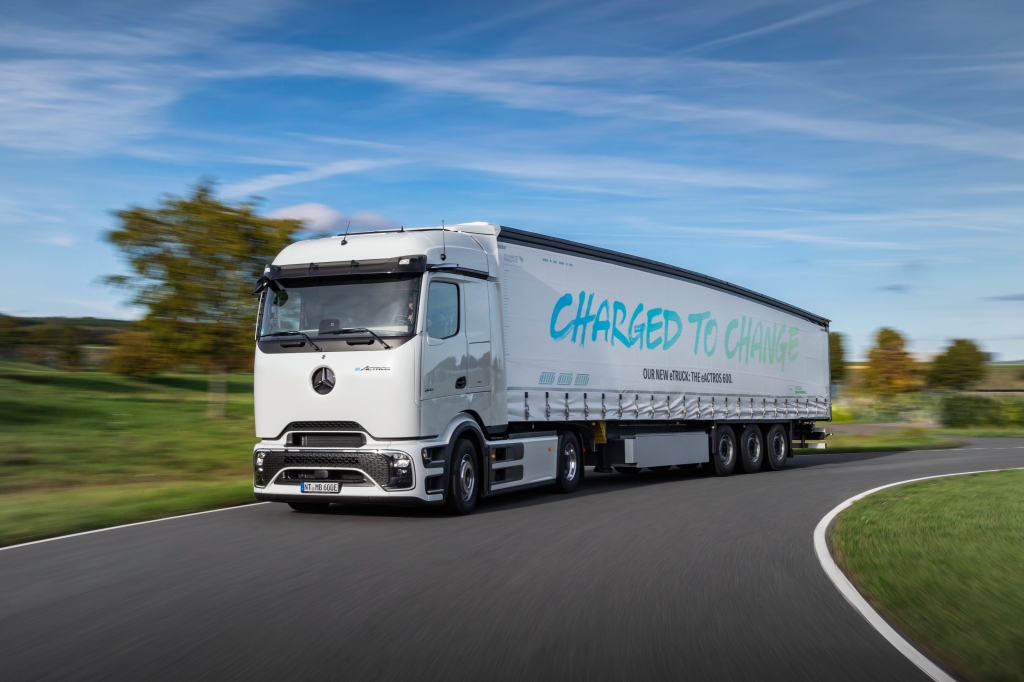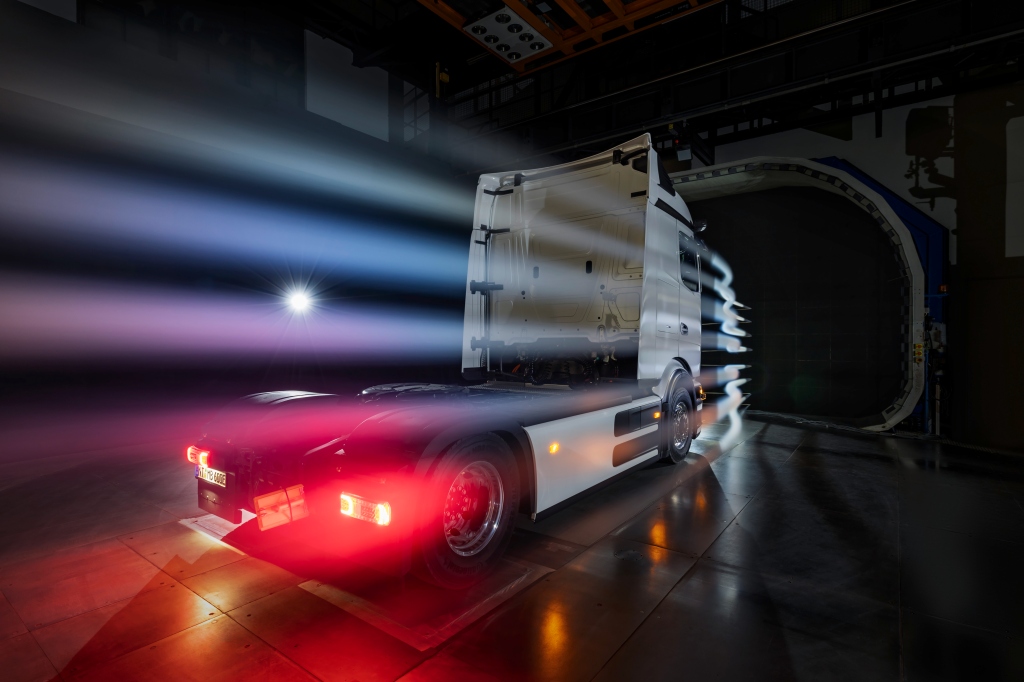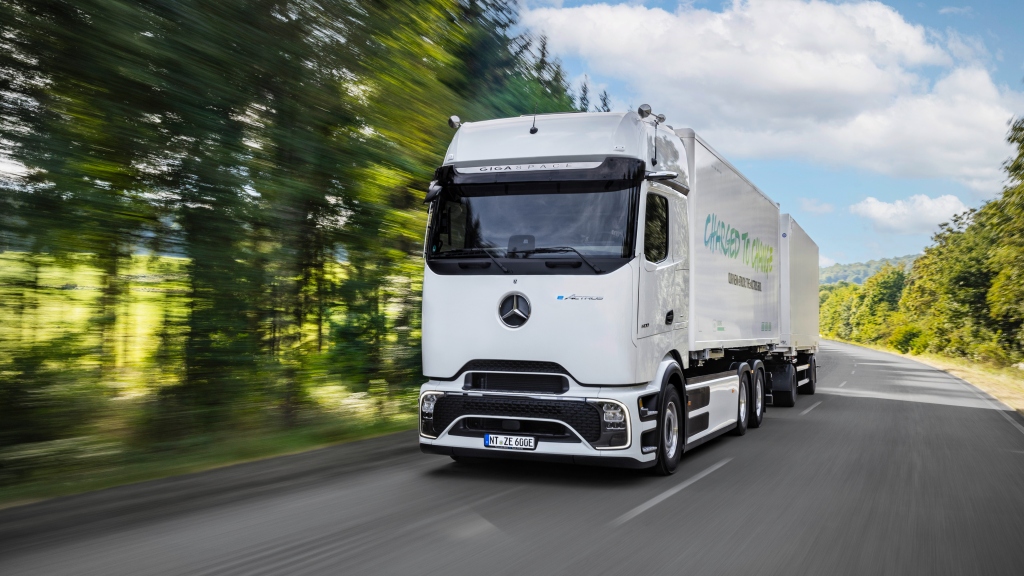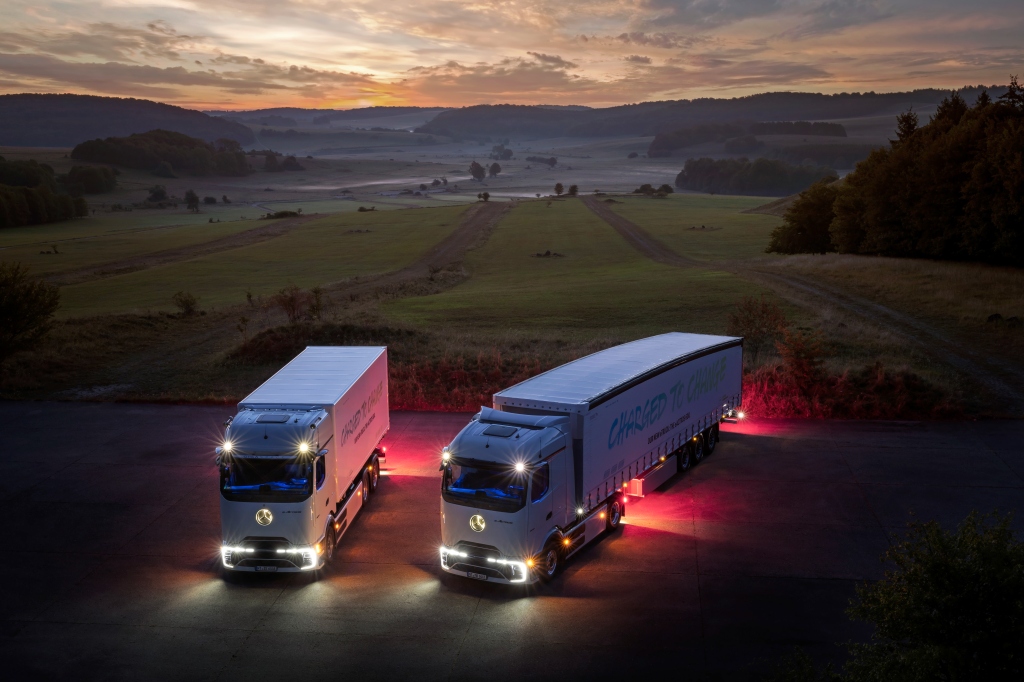
Finally Daimler Truck AG have launched their long distance tractor unit offering to the world. I will happily say i love the look of it and that is a good start. It may be a facelift and redesign around the current cab, but when the cab interior works so well how would you actually improve it. This truck is capable of 500Kn / 310 miles on a single charge, which makes it much more of a viable option for some long distance work. There is a lot of information about the truck in the press release, so i have given you what i think are the parts of the seven page release, that you will actually want to read. This will put Daimler out there with the good looking Volvo option, although we will have to wait until early 2025 for RHD options here in the UK I am told. If you would like to read the full complete press release then please click the link HERE.
The eActros 600 heavy-duty electric truck is planned to define the new standard in terms of technology, sustainability, design and profitability
- E-truck to replace majority of diesel trucks in the segment over the long term
- Range of 500 kilometers1 without intermediate charging
- Significantly more than 1,000 kilometers per day with intermediate charging during the legally prescribed driver breaks possible
- Gross combination weight of up to 44 tons
- Payload of around 22 tons with standard trailer
- Start of sales this year – start of series production planned for end of 2024
- New design language of the driver’s cab characterized by efficient aerodynamics
- More than 80 percent CO2 savings2 compared to diesel-truck over entire life cycle possible
- Karin Rådström, CEO Mercedes-Benz Trucks: “The eActros 600 stands for the transformation of road freight transport towards CO2-neutrality like no other truck with a three-pointed star. It is characterized by highly innovative drive technology that can offer our customers particularly high energy efficiency and thus profitability. This makes entry into e-mobility even more attractive for fleet operators.”


The high battery capacity of more than 600 kilowatt hours – hence the model designation 600 – and a new, particularly efficient electric drive axle developed in-house, enable the e-truck to achieve a range of 500 kilometers1 without intermediate charging. Therefore, the eActros 600 will be able to travel significantly more than 1,000 kilometers per day. This is made possible by intermediate charging during the legally prescribed driver breaks – even without megawatt-charging. Around 60 percent of long-distance journeys of Mercedes-Benz Trucks customers in Europe are shorter than 500 kilometers anyway, which means charging infrastructure at the depot and at the loading and unloading points is sufficient in such cases. For all other uses, continual expansion of public charging infrastructure is vital in order to make the electric truck viable for long-distance haulage across Europe. In addition to CCS charging with up to 400 kW, the eActros 600 will later also enable megawatt charging (MCS). From the start of sales, customers can order a pre-installation for this. As soon as MCS technology becomes available and is standardized across manufacturers, it is planned to be retrofittable for these models of the eActros 600. The batteries can be charged from 20 to 80 percent in about 30 minutes3 at a suitable charging station with an output of around one megawatt.
The vehicle is technically designed for a gross combination weight of up to 44 tons. With a standard semitrailer, the eActros 600 has a payload of around 22 tons in the EU. In some cases, national law may permit a higher payload. Visually, the e-truck is characterized by a fundamentally new, puristic design with clear lines and an aerodynamic shape. When it comes to profitability for fleet operators, the electric truck is intended to set new standards, over the long term replacing the majority of diesel trucks in the important long-haul transport segment. The core of Mercedes-Benz Trucks‘ concept for battery-electric long-distance transport is to offer customers a holistic solution consisting of vehicle technology, consulting, charging infrastructure and services.
Sales of the electric truck start this year. The start of series production is planned for the end of 2024. In addition to the tractor unit, Mercedes-Benz Trucks will also produce rigid variants of the eActros 600 right from market launch, offering customers further possible applications for all-electric transport. A fleet of around fifty prototype vehicles is currently being built, some of which are also to be put into practical testing with first customers in a next step.
Karin Rådström, CEO Mercedes-Benz Trucks: “The eActros 600 stands for the transformation of road freight transport towards CO2-neutrality like no other truck with a three-pointed star. It is characterized by highly innovative drive technology that can offer our customers particularly high energy efficiency and thus profitability. This makes entry into e-mobility even more attractive for fleet operators.”
Electricity price and toll system decisive for profitability compared to diesel trucks
The time period within which fleet operators can achieve cost parity with a comparable diesel truck using the eActros 600 in long-distance haulage differs from country to country, in particular depending on the electricity and diesel price and toll system. In the large transit countries of France and Germany, for example, a low electricity price and the planned CO2-based truck toll, respectively, have a positive effect on the operational costs of battery-electric trucks. This means that the eActros 600 can be more profitable than a diesel long-haul truck within the average vehicle holding period of around five years or after around 600,000 kilometers – despite a purchase price that is around two to two and a half times higher than the diesel equivalent. Government subsidization of e-trucks and charging infrastructure is a key lever providing support in ramping up the market. More than 80 percent CO2 savings possible compared to diesel trucks over the entire life cycle.


The eActros 600 has three battery packs, each with 207 kWh5. These offer an installed total capacity of 621 kWh. The batteries are based on lithium iron phosphate cell technology (LFP) and are characterized by a long service life. The development engineers at Mercedes-Benz Trucks have designed the eActros 600 to meet the same requirements on the durability of the vehicle and components as a comparable conventional heavy-duty long-haul Actros. That means up to 1.2 million kilometers in ten years of operation. After this period of use, the battery state of health should still be over 80 percent. Moreover, in contrast to other battery cell technologies, approximately 95 percent of the installed capacity can be used with LFP technology. This makes a higher range with the same installed battery capacity possible.
Innovative drive technology – Predictive Powertrain Control in the eActros 600
Mercedes-Benz Trucks has developed a new 800-volt electric axle with two electric motors and a four-speed transmission specifically for use in heavy-duty long-haul transport. The electric motors generate a continuous output of 400 kW as well as a peak output of 600 kW and ensure powerful acceleration, high driving comfort and high driving dynamics. The full motor output is available most of the time with almost no interruption in torque.
In addition, with an anticipatory driving style, electrical energy can be recovered through recuperation, which is fed back into the batteries of the eActros 600 and is then available again for the drive system. Recuperation puts less strain on the brakes of the eActros 600, which is a positive side effect. Depending on the situation, the driver can choose between five different recuperation levels. One-pedal driving can also be optionally enabled on the touchscreen in the digital cockpit – i.e. deceleration by means of recuperation with reduced actuation of the mechanical brake.
The eActros 600 features the tried-and-tested Predictive Powertrain Control (PPC) cruise and transmission control, which is specially tuned to the electric drive system. The anticipatory drivetrain control automatically takes into account the topography, course of the road and traffic signs for the most efficient style of driving. Route information from the navigation system is now included to facilitate better recognition of the situation on the road ahead. This allows the driver to avoid unnecessary braking, accelerating and shifting and to exploit the battery energy as efficiently as possible.


The new design language of the driver’s cab of the eActros 600 is characterized by particularly efficient aerodynamics. This is achieved with the large, completely closed and rounded-off front hood, an optimized bumper, including underbody paneling, an aerodynamically improved driver access and extended end flaps designed like sails. Air deflectors on the A-pillars, an additional spoiler on the roof and a sealed motor compartment complement the aerodynamic improvements to the cab. Over and above this, the cab is equipped with aluminum step plates, a new headlamp concept with matrix LED headlamps and an LED light strip. Mercedes-Benz Trucks markets the cab under the “ProCabin” name.
Specifically with battery electric trucks in long-haul operation, improved aerodynamics are of decisive importance as air resistance is one of the main factors influencing energy consumption. In addition, reduced air resistance means that more energy can be recovered through recuperation, leading to a longer range.
Extending the front by 80 millimeters made it possible to achieve the particularly aerodynamic shape of the new cab. This streamlined shape was developed in a multitude of in-house air-flow simulations as well as wind tunnel and on-the-road measurements. This enabled the ProCabin’s cW value to be lowered by nine percent6 in comparison to the Actros cab currently in series production. This aerodynamic improvement reduces the vehicle’s energy consumption and makes a decisive contribution to the range of 500 kilometers1 achieved by the eActros 600.
The eActros 600 is very quiet on the road for the benefit of the driver and its environment. To ensure that, for example, vulnerable road users such as pedestrians or cyclists can still notice the electric truck in their surroundings, it is equipped with an external Acoustic Vehicle Alerting System (AVAS) in accordance with legal requirements. Depending on the driving conditions, sounds are played for forward or reverse travel. In addition, the sound varies depending on the vehicle speed and accelerator pedal position, so that good acoustic perception is possible in urban traffic. The futuristic sound spectrum of the AVAS in the eActros 600 is designed to take into account the appearance of a heavy vehicle and to contribute to better recognizability in urban traffic. With the eActros 600, Mercedes-Benz Trucks is advancing its vision of accident-free driving. As was the case in previous years with the manufacturer’s vehicles, the installed safety assistance systems go beyond the legal requirements in many areas. This also applies to the General Safety Regulation adopted by the EU Commission. From mid-2024, the regulation prescribes the addition of systems as standard equipment for all new vehicles. The safety concept of the eActros 600 is based on the further development of tried-and-tested safety assistance systems. The basis for this is a completely new electronics platform which involves what is known as sensor fusion to merge radar and camera data for an even larger view to the front and side. For this purpose, the electronics platform offers 20 times higher data processing. The total of six installed sensors – 4 short range radars and one long-range radar – as well as the multifunction camera in the windshield cover an angle of 270 degrees around the vehicle.

The eActros 600 will be produced on the existing assembly line at the largest truck assembly plant of Mercedes-Benz Trucks in Wörth am Rhein – in parallel to and flexibly alongside the trucks that will continue to be equipped with a diesel drive. In Wörth, it will also be equipped with the electric drive components from the Mercedes-Benz plants in Mannheim, Gaggenau and Kassel. Like the Wörth site, the three locations are also undergoing a transformation from diesel technology to competence centers for emission-free transport. Installation in Wörth takes place in several production steps, including the installation of the electric axle, the high-voltage batteries and the front box, which is a complex technology module with several control units, high-voltage components and an electric air compressor. Once all high-voltage components have been installed, the entire system goes into operation and the truck is ready to drive.

